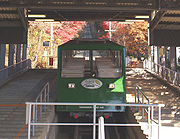
Mt. Tsukuba Cable Car
Encyclopedia

Funicular
A funicular, also known as an inclined plane or cliff railway, is a cable railway in which a cable attached to a pair of tram-like vehicles on rails moves them up and down a steep slope; the ascending and descending vehicles counterbalance each other.-Operation:The basic principle of funicular...
line on Mount Tsukuba
Mount Tsukuba
Mount Tsukuba is an mountain located near Tsukuba, Japan. It is one of the most famous mountains in Japan, particularly well-known for its double peaks, Nyotai-san and Nantai-san . Many people climb the so-called "purple mountain" every year for the panoramic view of the Kantō plain from the...
, Tsukuba, Ibaraki
Tsukuba, Ibaraki
is a city located in Ibaraki Prefecture, Japan. It is known as the location of the , a planned city developed in the 1960s.As of 2008, the city has an estimated population of 207,394 and a population density of 730 persons per km². Its total area is 284.07 km².Mount Tsukuba, particularly well-known...
. It is the only funicular line operates, while it also operates an aerial tramway
Aerial tramway
An aerial tramway , cable car , ropeway or aerial tram is a type of aerial lift which uses one or two stationary ropes for support while a third moving rope provides propulsion...
, hotels and restaurants. The company belongs to Keisei
Keisei Electric Railway
The is a major private railway in Chiba and Tokyo, Japan. The name Keisei is the combination of the kanji 京 from and 成 from , which the railways main line connects. The combination uses different readings than the ones used in the city names. The railway's main line runs from Tokyo to Narita and...
Group.
Basic data
- Distance: 1.6 km / 1.0 mi.
- GaugeRail gaugeTrack gauge or rail gauge is the distance between the inner sides of the heads of the two load bearing rails that make up a single railway line. Sixty percent of the world's railways use a standard gauge of . Wider gauges are called broad gauge; smaller gauges, narrow gauge. Break-of-gauge refers...
: 1,067 mm / 3 ft. 6 in. - Stations: 2
- Vertical interval: 495 m / 1,624 ft.
See also
- Mount Tsukuba Ropeway
- List of funicular railways
- List of railway companies in Japan
- List of railway lines in Japan

